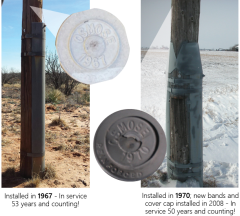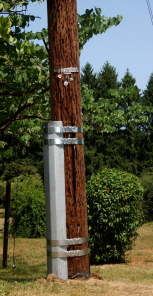T&D Times - June 2020
Celebrating 55 Years of Reliable Restoration
Osmo-C-Truss®: 55 Years of Reliable Restoration
 2020 marks the 55th anniversary of the Osmo-C-Truss wood pole restoration system. Installations of the C-Truss® and C2-Truss™ have restored over 1.5 million poles nationwide. These restorations also represent over $3 billion in savings for utility companies when compared to pole replacement costs. Furthermore, the wood pole life extension provided by these systems can be equivalent to the expected life of a pole replacement.
2020 marks the 55th anniversary of the Osmo-C-Truss wood pole restoration system. Installations of the C-Truss® and C2-Truss™ have restored over 1.5 million poles nationwide. These restorations also represent over $3 billion in savings for utility companies when compared to pole replacement costs. Furthermore, the wood pole life extension provided by these systems can be equivalent to the expected life of a pole replacement.
This paper shows a brief history of the C-Truss steel restoration method and includes data on the re-inspection of over 117,000 restored poles that validates successful life extension of over 40 years. Life extension of a utility asset qualifies for capital treatment and details of capital budget optimization are also explained in this document.
Wood Pole Restoration
The first wood utility poles were installed over 100 years ago and today an estimated 150 million wood poles provide the support system for much of the electric grid. As poles age while in service, the original preservative treatment may no longer be effective at preventing decay in the groundline zone. The most decay prone section of the pole is from groundline to 18 inches below ground.
Inspection of the groundline zone, especially when excavation is included, monitors the condition of a pole and is recommended and sometimes required on a cyclical basis. The excavation also provides the means to apply supplemental preservative treatment; a booster shot to the original treatment that helps prevent decay and extend the life of a pole.
Poles identified with a remaining bending strength at the groundline that is below the requirements of the National Electrical Safety Code (NESC) are often referred to as “rejected” poles or “rejects.” The code requires these poles to be restored or replaced.
 Pole restoration with the Osmo-C-Truss system has provided utility companies with a cost-saving option to pole replacement for 55 years. The steel truss is positioned against the pole and is driven into the ground to a depth well below the groundline decay zone. This forms a union with the sound portion of the pole below the decay zone, and the above ground portion of the truss is banded to sound wood above. The steel truss bridges across the decay zone and restores the bending capacity so the pole can remain safely in service.
Pole restoration with the Osmo-C-Truss system has provided utility companies with a cost-saving option to pole replacement for 55 years. The steel truss is positioned against the pole and is driven into the ground to a depth well below the groundline decay zone. This forms a union with the sound portion of the pole below the decay zone, and the above ground portion of the truss is banded to sound wood above. The steel truss bridges across the decay zone and restores the bending capacity so the pole can remain safely in service.
The flexibility of the installation method makes it possible to restore poles that are installed in rear-lots and in concrete, along with poles having various attachments and difficult access.
Due to the historical data validating significant life extension, the cost of the C-Truss system can be capitalized and used to help optimize capital budgets.
Read the entire whitepaper explaining the history of the C-Truss steel restoration method, how to ensure optimal life extension, our observations of over 1.5 million trussed poles, a case for capitalization, and more.
.png?width=243&name=Osmose-logo-(white).png)